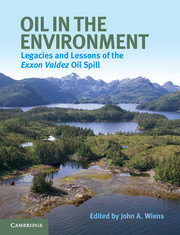Book contents
- Frontmatter
- Contents
- List of contributors
- Use of acronyms
- Acknowledgments
- A bibliographic note
- Prologue
- Part I Introduction and background
- 1 Introduction and background
- 2 The phases of an oil spill and scientific studies of spill effects
- Part II Oil in the environment
- Part III Biological effects
- Part IV Assessing oil spill effects and ecological recovery
- Part V Conclusions
- Index
- References
2 - The phases of an oil spill and scientific studies of spill effects
Published online by Cambridge University Press: 05 July 2013
- Frontmatter
- Contents
- List of contributors
- Use of acronyms
- Acknowledgments
- A bibliographic note
- Prologue
- Part I Introduction and background
- 1 Introduction and background
- 2 The phases of an oil spill and scientific studies of spill effects
- Part II Oil in the environment
- Part III Biological effects
- Part IV Assessing oil spill effects and ecological recovery
- Part V Conclusions
- Index
- References
Summary
Introduction and overview
Following a marine oil spill, it is important to know where the oil goes, how it changes chemically, how long the oil persists in various environmental compartments such as water or sediments, and what biological resources are affected. As an oil spill progresses over time, the behavior of the oil and the impacted areas and levels of risk to people and biological resources such as fish and wildlife change. Scientific studies provide the most benefit to cleanup efforts and the protection of people and biological resources in the area when they are coordinated and focused on the most pressing questions based on the phase of the oil spill. Over several decades, previous marine oil spills have shown a consistent pattern; understanding this pattern can help predict where the oil will go, how it changes chemically, where it will persist, and what living things are likely to be affected. Similarly, this predictability, coupled with specific observations at each spill, can help to provide a framework for designing and conducting studies that can address key questions at critical junctures in the evolution of the spill.
Water and air are the first environmental media affected during the early phase of any marine spill. Animal and plant life (or “biological resources”) can be affected immediately – as can humans involved in spill cleanup. The initial exposures to the chemicals in petroleum and the resulting effects can be acute, but short-lived. This is because once the spilled oil is no longer moving on or in the water, concentrations of harmful chemicals decrease rapidly owing to dilution, dispersion, and degradation (collectively known as “weathering”). Likewise, the evaporation of the volatile hydrocarbon components of fuels or crude oil immediately following a spill first increases, then decreases. By contrast, the effects on shoreline biological resources from oil that reaches land may persist. The last area potentially to be affected is bottom sediments, where oil can be transported before or after it reaches land (Chapter 4).
- Type
- Chapter
- Information
- Oil in the EnvironmentLegacies and Lessons of the Exxon Valdez Oil Spill, pp. 37 - 53Publisher: Cambridge University PressPrint publication year: 2013
References
- 2
- Cited by

